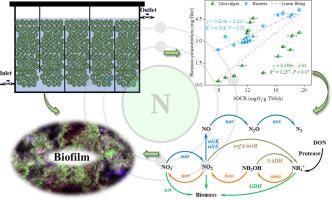Water Research ( IF 11.4 ) Pub Date : 2023-08-13 , DOI: 10.1016/j.watres.2023.120461 Beibei Wu 1 , Ting Ran 1 , Sibei Liu 1 , Qian Li 1 , Xiaocai Cui 1 , Yun Zhou 1

|
Non-aeration microalgae-bacteria biofilm has attracted increasing interest for its application in low cost wastewater treatment. However, it is unclear the quantified biofilm characteristics dynamics and how biofilm bioactivity affects performance and nitrogen metabolisms during wastewater treatment. In this work, a push-flow microalgae-bacteria biofilm reactor (PF-MBBfR) was developed for aeration-free greywater treatment. Comparatively, organic loading at 1.27 ± 0.10 kg COD/(m3⋅d) gave the highest biofilm concentration, density, specific oxygen generation (SOGR) and consumption rates (SOCR), and pollutants removal rates. Contributed to low residual linear alkylbenzene sulfonates and bioactivity, reactor downstream showed low bacteria and protein concentrations and SOCR (12.8 mg O2/g TSS·h), but high microalgae, carbohydrate, biofilm density, SOGR (49.4 mg O2/g TSS·h) and pollutants removal rates. Dissolved organic nitrogen (DON) showed higher molecular weight, CHONS and fraction with 4 atoms of N in reactor upstream. Most of nitrogen was fixed to newly synthesized biomass during assimilation process by related functional enzymes, minor contributed to denitrification due to low N2 emission. High nitrogen assimilation by microalgae showed high SOGR, which favored efficient multiple pollutants removal and reduced DON emission. Our findings favor the practical application of PF-MBBfR based on biofilm bioactivity, enhancing efficiency and reducing DON emission for low- energy-input wastewater treatment.
中文翻译:

在无曝气灰水处理过程中,生物膜生物活性影响推流微藻-细菌生物膜反应器中的氮代谢
非通气微藻-细菌生物膜因其在低成本废水处理中的应用而引起了越来越多的兴趣。然而,尚不清楚量化的生物膜特征动态以及生物膜生物活性如何影响废水处理过程中的性能和氮代谢。在这项工作中,开发了一种推流式微藻-细菌生物膜反应器(PF-MBBfR),用于无曝气灰水处理。相比之下,有机负荷为 1.27 ± 0.10 kg COD/(m 3 ⋅d) 时,生物膜浓度、密度、比氧生成量 (SOGR) 和消耗率 (SOCR) 以及污染物去除率最高。下游反应器的细菌和蛋白质浓度及 SOCR 较低(12.8 mg O 2 /g TSS·h),但微藻、碳水化合物、生物膜密度、SOGR 较高(49.4 mg O 2 /g TSS·h),这有助于降低残留直链烷基苯磺酸盐和生物活性。 ·h) 和污染物去除率。反应器上游的溶解有机氮 (DON) 显示出较高的分子量、CHNS 和含 4 个 N 原子的分数。大部分氮在同化过程中被相关功能酶固定到新合成的生物质上,由于N 2排放量低,少量有助于反硝化。微藻的高氮同化表现出高SOGR,有利于有效去除多种污染物并减少DON排放。我们的研究结果有利于基于生物膜生物活性的 PF-MBBfR 的实际应用,提高低能量输入废水处理的效率并减少 DON 排放。

















































 京公网安备 11010802027423号
京公网安备 11010802027423号